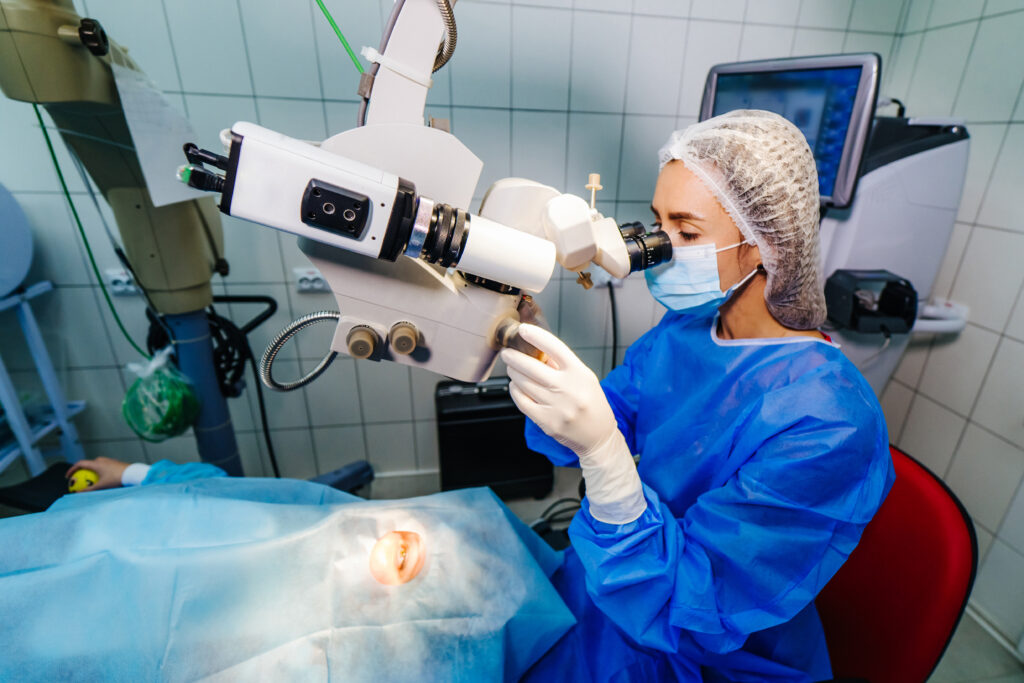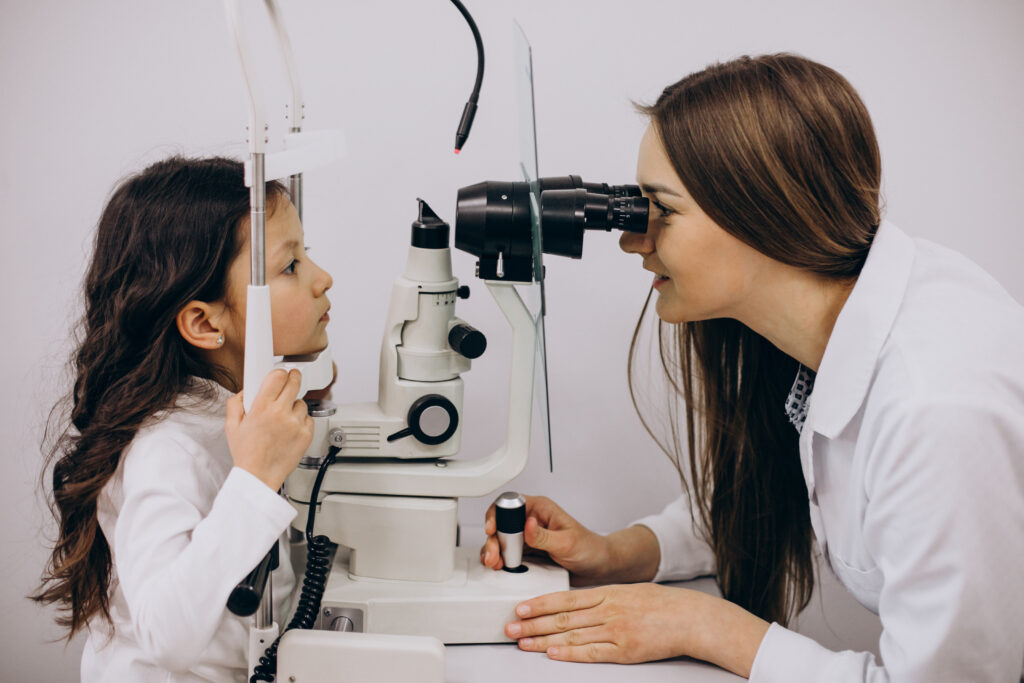Pediatric Services
- Home
- Pediatric Services
Netrodaya The Eye City Varanasi
Caring for the Vision of Our Youngest Patients
Common Pediatric Eye Conditions
Children can experience a variety of eye conditions that require expert care. Some of the most common conditions we treat include:
1. Refractive Errors
• Myopia (Nearsightedness): Difficulty seeing distant objects clearly.
• Hyperopia (Farsightedness): Difficulty seeing close objects clearly.
• Astigmatism: Blurred vision due to an irregularly shaped cornea.
2. Strabismus (Crossed Eyes)
Strabismus occurs when the eyes do not align properly, leading to one eye turning in, out, up, or down. Early diagnosis and treatment are crucial to prevent vision problems and improve eye alignment.
3. Amblyopia (Lazy Eye)
Amblyopia is a condition where one eye has reduced vision because the brain favors the other eye. It is often associated with strabismus or significant refractive error differences between the eyes. Early intervention is essential to strengthen the weaker eye.
4. Congenital Cataracts
Cataract in children can be present at birth or develop during childhood. They can interfere with vision development and require surgical intervention to restore clear vision.
5. Blocked Tear Ducts
Blocked tear ducts are common in infants and can cause excessive tearing and eye discharge. Most cases resolve with time, but some may require medical intervention.


Diagnostic Services
1. Comprehensive Eye Exams
Regular eye exams are essential to monitor visual development and detect any issues early. Our comprehensive exams include visual acuity tests, eye alignment assessments, and a thorough examination of the eye structures.
2. Visual Field Testing
Visual field tests assess the child’s peripheral vision, helping detect conditions that may affect their overall field of vision.
3. Retinoscopy
Retinoscopy is a technique used to determine refractive errors in children. It is particularly useful for young children who may not be able to communicate their vision problems.
4. Ocular Imaging
Advanced imaging techniques, such as Optical Coherence Tomography (OCT) and fundus photography, allow us to examine the retina and optic nerve in detail, helping diagnose and monitor various eye conditions.
Treatment Options
1. Prescription Glasses and Contact Lenses
Corrective lenses are commonly used to address refractive errors. Our pediatric optometrists work closely with families to find the most suitable eyewear options for children.
3. Vision Therapy
Vision therapy involves a series of exercises designed to improve eye coordination, focusing, and tracking skills. It is particularly effective for conditions like strabismus and convergence insufficiency.
4. Medications
Certain eye conditions, such as infections or inflammation, may require medications. We prescribe safe and effective medications tailored to the needs of young patients.
5. Surgical Interventions
In some cases, surgery may be necessary to correct eye conditions. Our pediatric ophthalmic surgeons are skilled in performing a range of procedures, including:
• Strabismus Surgery: To correct misaligned eyes and improve binocular vision.
• Cataract Surgery: To remove cloudy lenses and restore clear vision.
• Ptosis Surgery: To lift drooping eyelids and enhance vision.
• Tear Duct Surgery: To clear blocked tear ducts and prevent infections.
Child-Friendly Environment
We understand that visiting the eye doctor can be intimidating for children. Our Pediatric Ophthalmology Department is designed to be a child-friendly space, with:
• Welcoming Decor: Bright, cheerful colors and decor to create a comforting atmosphere.
• Play Area: A dedicated play area to keep children engaged and relaxed while waiting.
• Friendly Staff: Our staff is trained to interact with children in a gentle and reassuring manner, making their experience as stress-free as possible.
Parental Guidance and Support
We believe in involving parents in every step of their child’s eye care journey. Our team provides detailed guidance and support to help parents understand their child’s condition and treatment options. Choose Netrodaya best eye hospital for best paediatric ophthalmology treatment in Varanasi and Uttar Pradesh. We have best eye doctors for squint treatment to deliver best results in Varanasi. We offer:
• Educational Resources: Informational materials and resources to help parents learn about common eye conditions and care practices.
• Counseling: One-on-one counseling sessions to address any concerns or questions parents may have about their child’s eye health.
• Follow-Up Care: Regular follow-up appointments to monitor progress and make any necessary adjustments to the treatment plan.
Why Pediatric Ophthalmology?
• Children’s eyes are constantly developing, and early detection and treatment of eye problems are crucial to prevent long-term vision issues. Pediatric ophthalmologists are specially trained to diagnose, treat, and manage eye conditions in children, ensuring they receive age-appropriate care.
Our Expertise
Our team of experienced pediatric ophthalmologists, orthoptists, and support staff are experts in dealing with the unique challenges of pediatric eye care. We are equipped with state-of-the-art technology and child-friendly facilities to provide a comfortable and welcoming environment for our young patients.
Frequently Asked Questions
Cataract are a condition where the clear lens of the eye becomes cloudy or opaque, leading to a gradual decline in vision. This clouding happens due to the clumping of proteins in the lens, often as a result of aging. As cataract develop, they can cause symptoms like blurry vision, difficulty seeing in low light, glare sensitivity, and faded colors. Left untreated, cataract can significantly impact daily activities and may lead to vision loss.
At Netrodaya, specialized cataract treatments and surgeries are available to restore clear vision.
Typical signs of cataract include:
• Having a general haze or blur, as though through frosted glass, is known as blurry vision.
• Night Vision Issues: Having trouble seeing at night due to headlight or streetlight glare.
• Colours that seem more yellowed and less vibrant are called faded colours.
• Increased Sensitivity to Glare: Having trouble with glare from the sun and bright lights.
• Seeing more than one image or a ghosting effect in one eye is known as double vision.
• Regular Prescription Glasses Changes: There is a discernible and regular requirement for updated prescriptions.
A complete eye examination at Netrodaya can aid in the diagnosis of cataract and assist select the most effective course of action to relieve these symptoms.
It could be a period to think about cataract surgery if you're having symptoms like double vision, fuzzy vision, difficulties seeing at night, faded colours, increased sensitivity to glare, or frequent adjustments to your prescription glasses. Through a thorough eye exam, an eye specialist at Netrodaya can define the severity of your cataract. They will consider how much your cataract interfere with your day-to-day activities and choose whether surgery is required to get your vision back to normal.
The most effective treatment for cataract at Netrodaya is cataract surgery, which involves replacing the cloudy lens with a clear artificial lens to restore clear vision.
Cataract surgery at Netrodaya involves removing the cloudy lens and replacing it with a clear artificial lens. This procedure is highly effective for restoring clear vision and improving quality of life.
Cataract surgery at Netrodaya is typically not painful. The process is performed under local anesthesia, which numbs the eye area. Patients may experience mild pain or anxiety but generally report minimal pain during and behind the surgery.
After cataract surgery at Netrodaya, recovery usually involves a few days of rest and avoiding strenuous activities. Patients may experience blurry vision initially, but clearness improves as the eye recovers. Eye drops are prescribed to control infection and reduce inflammation. Regular follow-up appointments ensure proper recovery and optimal vision. Most people resume normal activities within a week or two.
At Netrodaya, many patients start noticing improvement in their vision within a day or two after cataract surgery. However, full visual recovery may take a few weeks as the eye continues to heal and adjust. Follow-up appointments help monitor progress and ensure optimal results. Most people experience significant vision improvement within a week or two.
At Netrodaya, cataract surgery is generally safe, but risks include infection, bleeding, or vision issues like glare or double vision. Improvement is usually noticeable within a day or two, with full recovery taking a few weeks. Regular follow-up helps manage any complications and ensures optimal healing and vision clarity.
After cataract surgery at Netrodaya, avoid heavy lifting, bending over, or strenuous activities for a few weeks. Protect your eyes from dust and bright sunlight, and use prescribed eye drops as directed. Attend follow-up appointments to monitor healing. Gradually resume normal activities while following your doctor’s advice to ensure optimal recovery and prevent complications
